Cyprus – a jewel in the crown of the Mediterranean, blessed with sandy beaches and dazzling sunshine, hosting lush rugged landscapes cloaked in a blanket of a thousand wildflowers and enjoying a rich variety of birdlife that these Mediterranean islands so often hold. A small island with a long history and rich culture spanning 10,000 years (making Cyprus one of the oldest civilisations in the Mediterranean) the trip proved to be an ideal chance to explore both the varied birdlife this charming island offers, as well as appreciating the Roman architecture, temples and ruins that Cyprus is famous for.



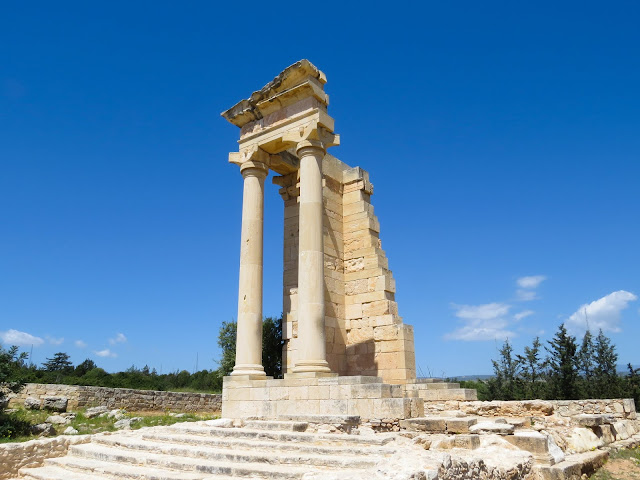
Cyprus’s position in the Mediterranean means it is used as a crucial stopover site by migrating birds during their sea crossing, and we timed our trip to coincide with the hotly anticipated spring migration period (which brings with it the promise of such hoped for goodies as Blue-cheeked Bee-eater and Caspian Plover alongside the more regular flycatchers and warblers). Unfortunately however things didn’t quite go to plan in what many visiting birders on the island noted was one of the quietest springs they had seen in recent years - indeed, we failed to find a single flycatcher of any species, and scored just a solitary Eastern Bonelli’s Warbler during the week, both Ruppell’s and Eastern Orphean Warblers noticeable by their absence.
 |
| We sadly failed to catch up with any Blue-cheeked Bee-eaters during our visit |
Never the less, we saw success in terms of the islands key endemics on our trip, scoring outstanding views of both Cyprus Pied Wheatear and Cyprus Warbler, as well as excellent perched views in the torchlight of calling Scops Owls, while a smattering of the familiar and expected Cyprus specialities such as Spur-winged Plover, Black Francolin and Chukar boosted our spirits. The sheer lack of migrants of any quality at many of the sites we visited was bitterly disappointing however, and even though we worked each location hard we quite often saw very little in return for our efforts, with localities that had seemed so promising in guide books and trip reports appearing almost devoid of birds apart from a handful of Chiffchaffs, Blackcaps and Whitethroats.
 |
| Cyprus Scops Owl - a speciality of Cyprus |
Housekeeping
Our trip to Cyprus involved exploring the western part of the island near Paphos for the majority of our stay, covering sites such as the Akrotiri peninsular, (Ancient Kourion, Lady’s Mile, Zakaki Pool, Akrotiri Gravel Pits and Ayia Geoghios), Paphos Headland, Anarita Park, Mandria, Paphos Sewage Works, Asprokremmos & Mavrokolympos Dams as well as day trips over to the east to explore the migrant hotspot that is Cape Greco Headland (also incorporating Oroklini Marsh and Ayia Napa Sewage Works in to our visit) and a trip to the mountains in order to search for the subspecies endemics at Troodos. We didn’t venture over to the Turkish part of Cyprus at all during our stay, instead staying on the southern Greek side.
 |
| Oroklini Marsh |
 |
| Paphos Headland |
 |
| Cape Greco Headland |
11 lifers and 86 species in total (as well as 3 endemic subspecies) were seen during our 5 days in Cyprus, covering the 3rd April – 7th April 2018, with specific targets such as Cyprus Warbler, Cyprus Pied Wheatear, Ruppell’s Warbler, Black Francolin, Spur-winged Lapwing, Cyprus Scops Owl, Chukar and Armenian Gull all on offer. In the end, both Ruppell’s Warbler and Armenian Gull sadly eluded us.
 |
| Cyprus Warbler |
 |
| Cyprus Wheatear |
 |
| Spur-winged Plover |
We hired a car for the duration of the trip from Hertz and flights were direct return from Manchester to Paphos. We stayed in one hotel for the entirety of our stay – the flamboyantly decorated Roman Boutique Hotel – which was situated in Paphos just minutes away from the headland and directly opposite Kings Avenue Mall (which proved extremely convenient for food in the evening). Our base meant we were well placed for all of the sites on the south western side of the island, and our day trip to the eastern side of the island took just over 2 hours. Encompassing both birding locations and archaeological sites, our trip combined the perfect mix of both, ensuring we got a taste of the historical aspects that Cyprus has to offer as well as its rich bird life.
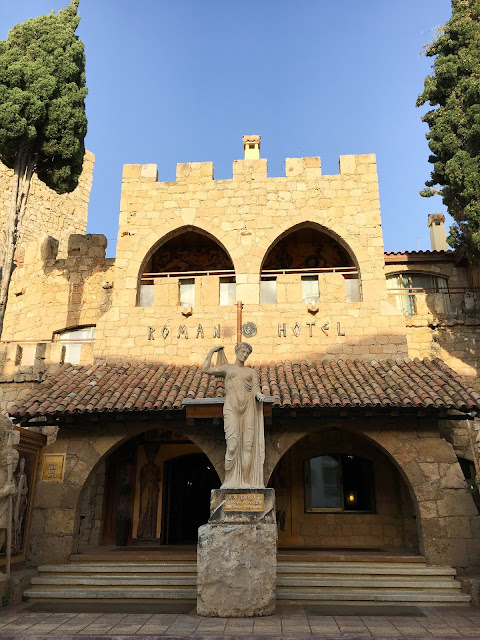 |
| Roman Boutique Hotel |
Daily Diary
With our flight not touching down in Paphos airport until late on the Monday evening, there was naturally no time for birding in the darkness, so a late check-in at our Roman-themed hotel complete with pot noodle snack and a quick shower before bed was all we had time for.
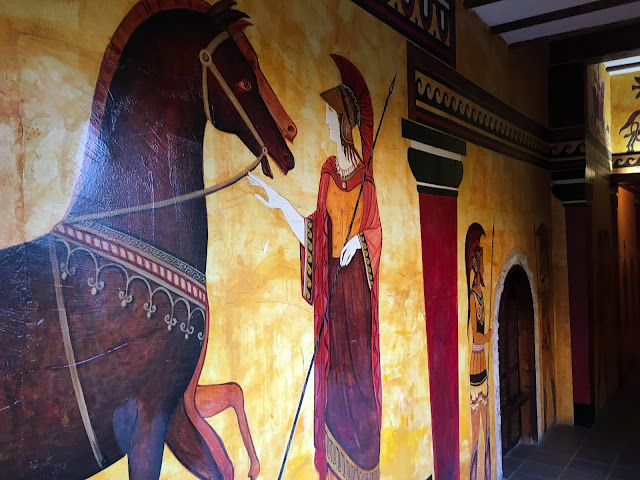 |
| The flamboyant interior of the Roman Boutique Hotel |
Awaking bright and early the next morning to glorious sunshine, we made good time in arriving at our first destination of the trip – the Akrotiri Peninsular on the southernmost tip of the island. Situated a little way east of Paphos, we’d decided to visit here first due to the sheer abundance of birding sites in one general location, with Akrotiri gravel pits, Agios Georgios chapel, Zakaki Pool, Lady’s Mile beach and Ancient Kourion all in close proximity to each other.
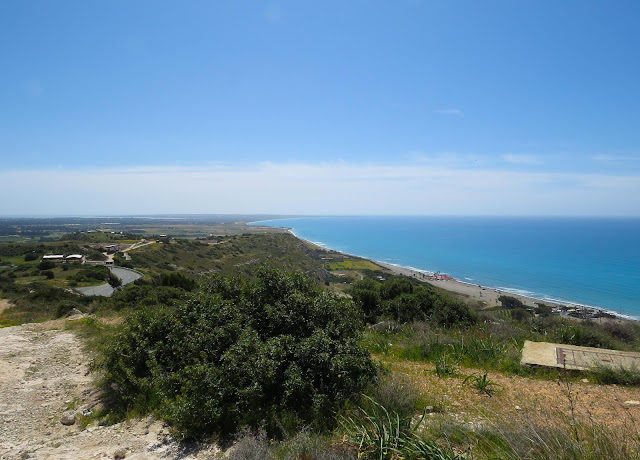 |
| The views from Ancient Kourion |
Before we’d even arrived at our first site of the day, a chance pull in at the side of the road in some suitable habitat resulted in our first new bird of the trip and one at the top of our most wanted lists – a stunning male Cyprus Warbler perched in one of the gorse bushes, singing loudly and showing off his piercing scarlet eye ring and blotched black chest in all its glory. Firing off photos as he moved closer and closer to the car, one of our main Cyprus endemics had been ticked off within minutes – apparently as easy as that!
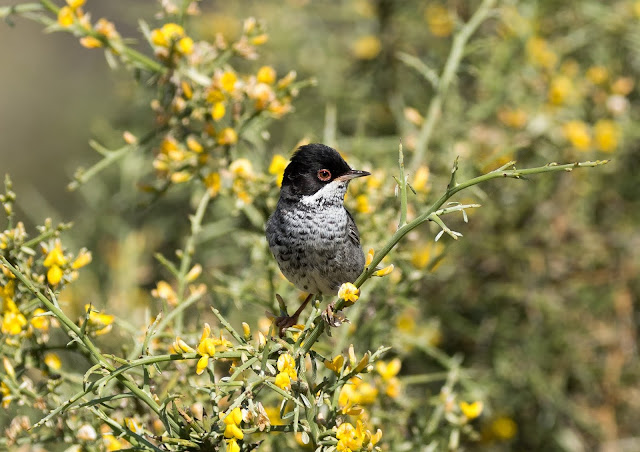 |
| Cyprus Warbler - our first new bird of the trip and our most wanted |
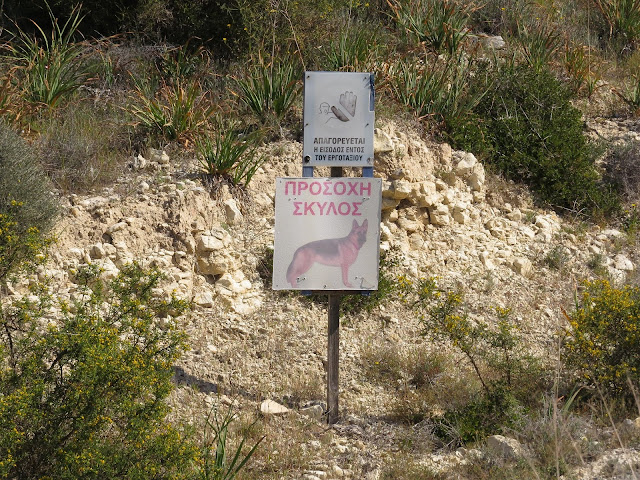 |
| Presumably "Beware of the Dog" in Cypriot Greek! |
With some reports indicating that Cyprus Warblers were in decline due to competition from the more successful Sardinian Warblers, we were therefore surprised to see them in good numbers during our trip at several of our sites – indeed another stop off further down the road resulted in a second bird just minutes later, albeit not as showy as the first.
 |
| Cyprus Warbler - not quite as showy as the first! |
Enjoying crippling views of this stunning endemic and with our trip off to a flying start, we carried on to our first stop of the day – Kourion Stadium (part of the Ancient Kourion archaeological site).
 |
| The Stadium of Ancient Kourion |
Pulling up next to the ruined walls of the stadium we explored the dried gorse around the perimeter – ebird records suggesting this was a good site to try for Ruppell’s Warblers. Sadly after several hours searching in the baking hot sun our efforts proved fruitless, with plenty of Sardinian Warblers, a smattering more Cyprus Warblers and a lone Eastern Subalpine Warbler all we had to show for our efforts.
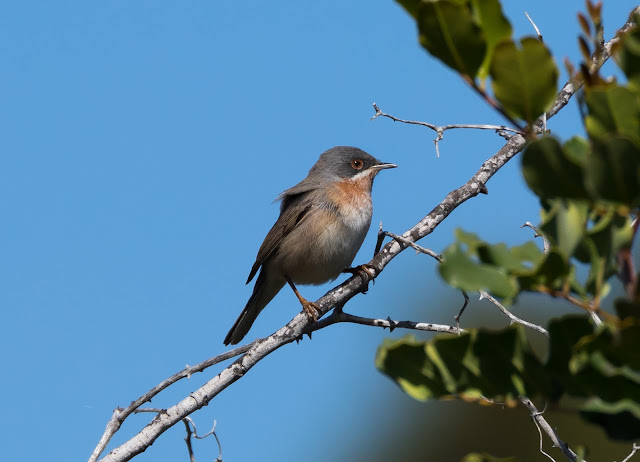 |
| Eastern Subalpine Warbler - not a current IOC split from its Western counterpart |
 |
| Suitable looking habitat around the stadium |
Two calling Great-spotted Cuckoos flying from tree to tree were our first abroad, while a dark coloured bird flitting around a chain link fence proved to be the next endemic on our hit list in the form of a cracking male Cyprus Pied Wheatear. Approaching closer as it dashed out catching insects, this turned out to be the first of many Cyprus Pied Wheatears we found during our trip, and overall they proved to be a refreshingly abundant and showy endemic, widespread in rocky habitats on the island. Indeed, upon returning to the stadium we caught sight of a second bird perched high in a tree, calling loudly with its distinct and unusual song before giving good views on the dry stone walls.
 |
| Cyrpus Wheatear - another main target and relatively common across Cyprus |
With the scorching hot sun now starting to burn our shoulders, we quickly moved on to our next port of call, the archaeologically important Apollo Hylates's temple. More of a sightseeing stop off than a birding destination, it was therefore refreshing to find 3 male Ortolan Buntings feeding in the grass next to the temple (ironically our only birds of the trip) and thankfully they didn’t flush by the time Alex had arrived from the car!
 |
| Ortolan Bunting |
 |
| Perfect Ortolan Bunting habitat |
As well as the temple itself, the ruins held a pair of extremely showy Cyprus Pied Wheatears, again displaying and calling out their distinctive song in earnest, while the usual Sardinian Warblers busied themselves in the scrub.
After our initial success the days birding seemed to grind to a bit of a halt from this point on – Agios Georgios chapel revealed no interesting migrants in the surrounding trees and only a handful of Bug Orchids (Anacamptis coriophora) well past their best were the only point of note.
 |
| Bug Orchids - thankfully a few were still in relatively good condition |
Lady’s Mile beach was equally as disappointing with no sign of any of our hoped for Armenian Gulls, instead just a single lonely Baltic (Lesser Black-backed) Gull frequenting one of the pools while a small flock of Greater Flamingos clustered distantly on the large salt lake in the centre of the peninsular.
 |
| Baltic Gull |
The small pool at Zakaki also proved fruitless, being completely dried up (and swarming with mosquitos!) with the reeds so overgrown that it offered no chance of spotting any of the Baillon’s or Little Crakes that had previously frequented this crake hotspot. A lone Crested Lark kept us company on the sandy road while we fuelled up on Pringles and biscuits for lunch, before we headed around to Akrotiri Marsh and Gravel Pits to see if we could improve on our luck.
Exploring the small hide on the marsh resulted in a showy Glossy Ibis feeding close-by in the water, while a number of Ruff fed around the cattle in the adjacent marshy fields.
 |
| Glossy Ibis |
Despite hearing the distinctive mechanical calls of multiple Black Francolins in the long grass, we were unable to spot any movement in the thick vegetation so headed further out to see what else the site held, our first Hoopoe of the trip giving prolonged and close views as we pulled away in the car.
 |
| Hoopoe |
A large colony of impressive Eastern Ploughshare Tongue Orchids (Serapias bergonii) at the side of the road further down the track provided a welcome opportunity to get some photos of this Mediterranean species, my second new orchid species for the trip, while up to six Purple Herons took flight from the nearby pools and powered off in to the distance.
 |
| Serapias Bergonii - Eastern Ploughshare Orchid |
At this point, an army truck speeding towards us down the dusty track made it clear that we had strayed a little too close to army territory. Thankfully, a quick inspection of our cameras and a lack of any photos of a military nature was enough to satisfy the army officials we were here solely for the wildlife (and not to garner military intelligence) - a point to consider when birding in any areas in Cyprus with military presence (and there are a fair few) – don’t venture to close with your cameras and optics!
Heading away from any further army interactions, the mechanical calling of more Black Francolins once more caught our attention, and after a careful scan across the marsh Alex expertly picked out the outline of a smart male, calling vociferously from the top of one of the most distant mounds and giving good scope views before it melted away back in to the vegetation.
 |
| An extreme record shot of a Black Francolin - honest! |
Satisfied that we had finally caught up with what is now an elusive and seemingly declining species on Cyprus, we decided to head back towards Paphos, a single Eastern Black-eared Wheatear on a cluster of large stone piles briefly testing our Wheatear ID as we left Akrotiri.
 |
| Eastern Black-eared Wheatear |
With a few hours to kill before dusk and with Alex needing a power nap, this meant I was also able to explore Aphrodite’s Rock on the journey back (the spot where according to legend the goddess Aphrodite rose from the sea) garnering a few souvenirs from the gift shop in the process while Alex slept.
 |
| Aphrodite’s Rock |
During our trip we had been using Gosney’s “Where to find birds in Southern Cyprus”, and following the instructions in the book to the letter we arrived at the exact spot on the road down to Mavrokolympos Dam where the calling Cyprus Scops Owls are said to show well. Recently split due to their much darker colouration and distinctive call differing from European Scops (Cyprus Scops have one strong note followed by a second quieter note of a different pitch) we pulled up next to the cliffs to find another set of birders already present, joining them to listen out for our final Cyprus endemic.
 |
| The telephone wires of Mavrokolympos Dam that the Cyprus Scops Owls often sit on |
A single Chukar calling loudly on the opposite hillside eventually revealed itself as the gloom set in (my first of the trip) and sure enough, like clockwork, as the light began to fade the high pitched double “bong” calls of Cyprus Scops echoed out across the valley.
Straining our eyes and ears to try and pinpoint the source of the call with no luck, it was therefore a relief when finally a small dark owl flew across the valley and on to the cliffs next to us, disappearing in to the craggy outcrop and out of sight. Thankfully, with a bit of patience and perseverance, we were able to secure brief (but excellent) views as one of the birds flew down to the exposed rock right in front of us, yellow eyes glaring down before flying off higher up the slope. Result!
With Cyprus Scops in the bag and the temperature really starting to drop, we headed back to our hotel happy after what had been a busy first day, venturing over to the nearby mall to demolish two much needed large pizzas before getting ready for the next day’s birding around Paphos.






















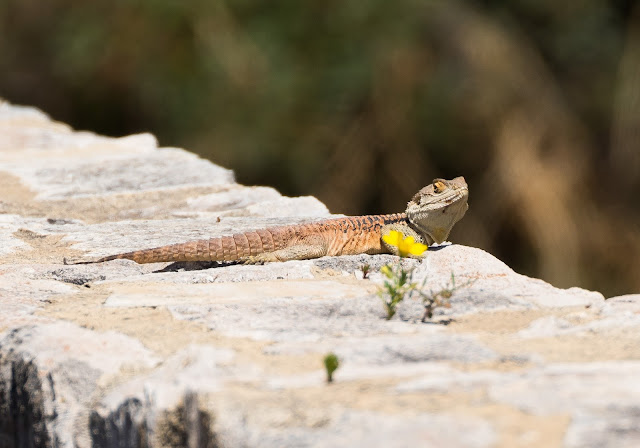















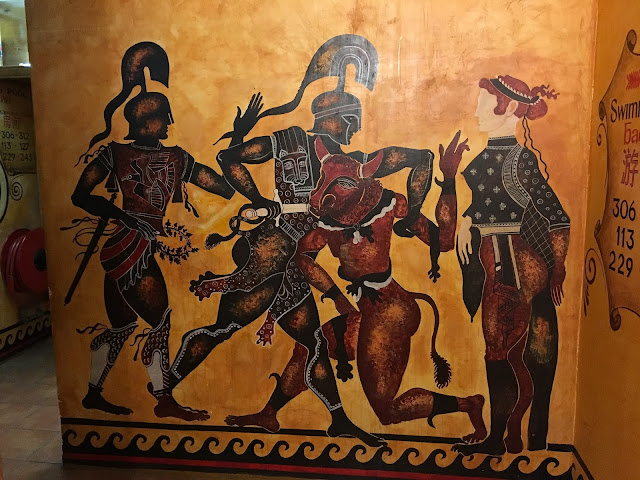








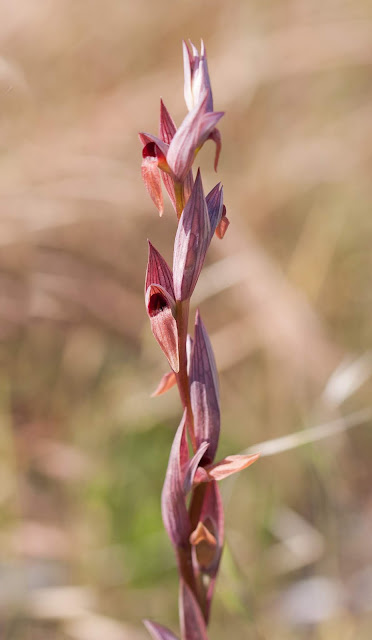





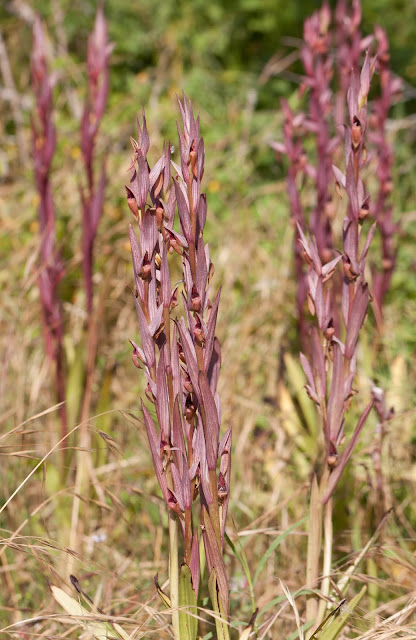
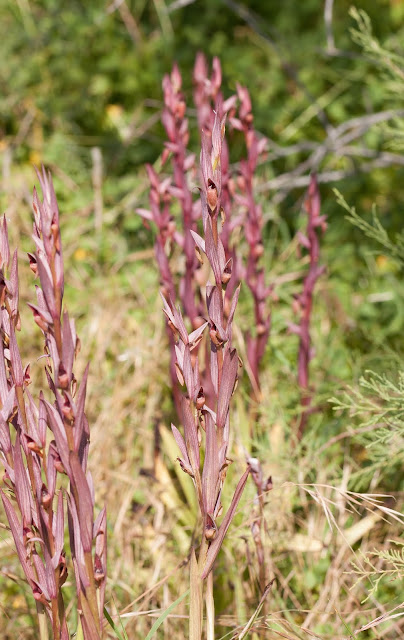





No comments:
Post a Comment